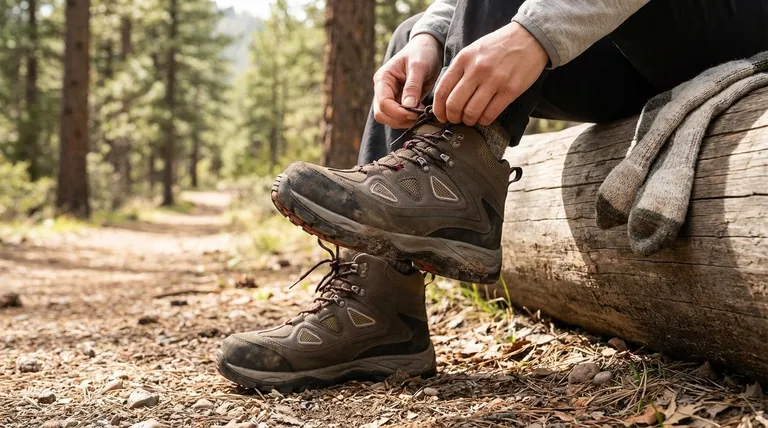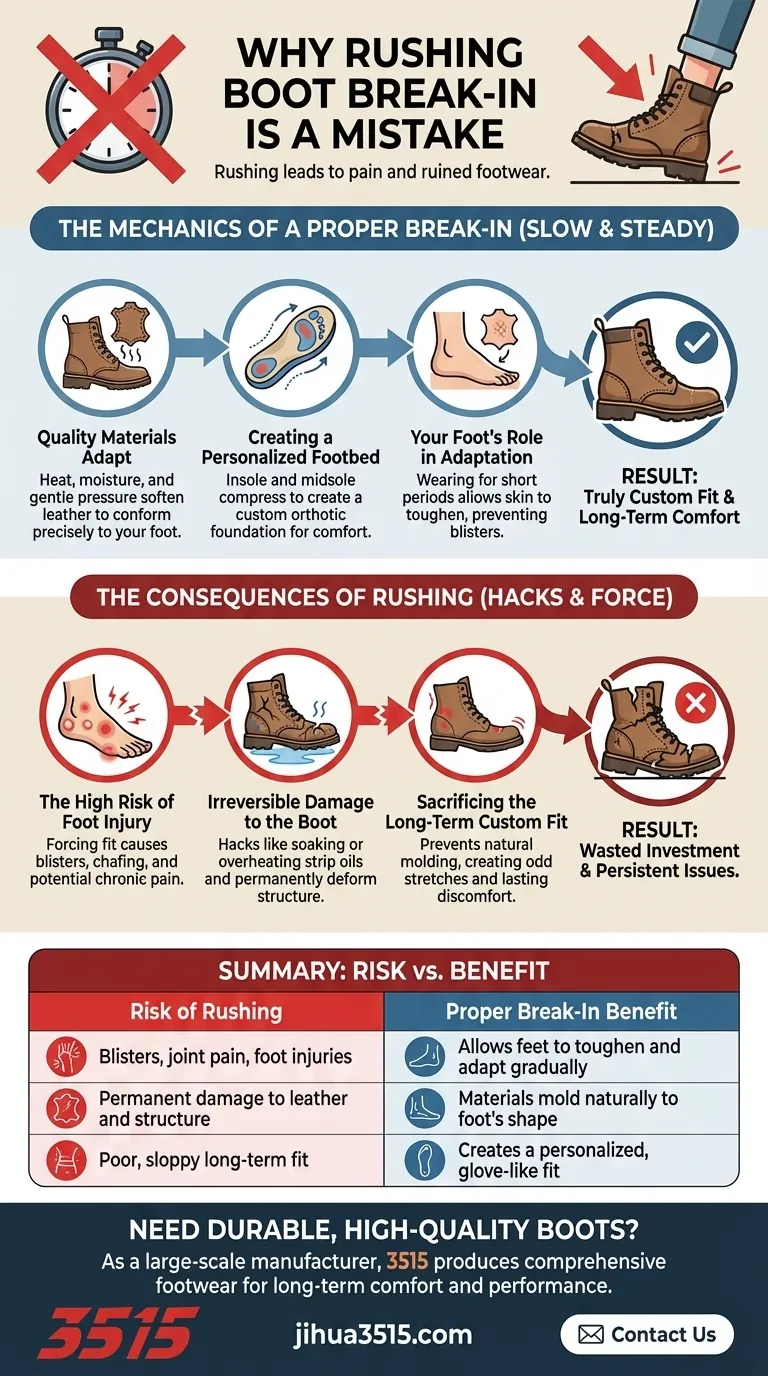Rushing the boot break-in process is a direct path to foot pain and ruined footwear. Attempting to force a new, stiff boot to conform to your foot with aggressive methods can cause injuries ranging from severe blisters to lasting joint pain. It also risks permanently damaging the boot's structural materials, leading to a poor long-term fit and a wasted investment.
The core principle of breaking in boots is not about forcing them to fit, but about allowing the footwear and your feet to gradually and mutually adapt. This slow, symbiotic process creates a truly custom fit that hasty shortcuts can never replicate and often destroy.

The Mechanics of a Proper Break-In
To understand why patience is critical, you must first understand what is happening to the boot and your foot during a successful break-in period. It is a process of molding, not stretching.
How Quality Materials Adapt
High-quality boots, particularly those made of leather, are designed to change over time. The heat and moisture from your foot, combined with the gentle pressure of walking, slowly soften the leather fibers.
This allows the material to conform precisely to the unique contours of your foot, especially around the ankle, heel, and the widest part of your forefoot.
Creating a Personalized Footbed
The insole and midsole are just as important as the upper. Materials like cork, leather, and dense foam will gradually compress under your high-pressure areas.
Over time, this creates a perfect impression of your sole—a custom orthotic unique to your gait and arch. This is the foundation of long-term comfort and support.
Your Foot's Role in Adaptation
The process is a two-way street. Your feet also need time to adjust to the new support structure and potential pressure points of the boot.
Wearing boots for short, controlled periods allows your skin to toughen in new contact areas, preventing the blisters and raw spots that occur when you do too much, too soon.
The Consequences of Rushing
So-called "break-in hacks" that promise instant comfort often cause irreversible harm. They violate the principles of gradual adaptation and can lead to significant problems.
The High Risk of Foot Injury
Forcing your foot into a stiff boot for an extended period creates intense, focused pressure. This is a direct cause of painful blisters, chafing, and even nerve compression.
In severe cases, an improper fit caused by a rushed break-in can contribute to chronic conditions like plantar fasciitis or aggravate existing joint issues.
Irreversible Damage to the Boot
Methods like soaking boots in water or overheating them can permanently damage the materials. Water can strip essential oils from leather, causing it to become brittle and crack once it dries.
Excessive stretching can tear internal stitching or permanently deform the boot's structure, creating a sloppy fit that promotes heel slip and instability. A boot that is improperly stretched will never fit correctly.
Sacrificing the Long-Term Custom Fit
The ultimate goal is a boot that feels like an extension of your foot. Rushing the process prevents the materials from molding naturally.
Instead of a glove-like fit, you get a boot with oddly stretched-out spots and remaining pressure points, completely defeating the purpose of investing in well-made footwear.
Making the Right Choice for Your Goal
To achieve the perfect fit without pain or damage, you must commit to a patient and methodical process.
- If your primary focus is a long-lasting, custom fit: Commit to a gradual break-in, wearing new boots for only 1-2 hours at a time indoors before venturing on short walks.
- If you are experiencing a specific, localized pain point: Use a targeted solution like a boot stretcher for that single spot or consult a professional cobbler for adjustments.
- If you absolutely cannot wait: Choose footwear made from softer, more forgiving materials that require minimal break-in, but accept the potential trade-off in durability and long-term support.
Treating the break-in period as the final, critical stage of the boot-making process is the only way to unlock the true comfort and longevity of your investment.
Summary Table:
| Risk of Rushing | Proper Break-In Benefit |
|---|---|
| Blisters, joint pain, and foot injuries | Allows feet to toughen and adapt gradually |
| Permanent damage to leather and structure | Materials mold naturally to your foot's shape |
| Poor, sloppy long-term fit | Creates a personalized, glove-like fit and footbed |
Need durable, high-quality boots that are worth the proper break-in?
As a large-scale manufacturer, 3515 produces a comprehensive range of footwear for distributors, brand owners, and bulk clients. Our production capabilities encompass all types of durable shoes and boots designed for long-term comfort and performance.
Contact us today to discuss your footwear needs and discover how our manufacturing expertise can deliver the reliable products your customers demand.
Visual Guide

Related Products
- Safety Footwear Wholesale Manufacturer for Custom OEM/ODM Production
- Custom Wholesale Leather Safety Boots Direct Factory Manufacturing
- Customizable Anti-Smash Safety Boots for Wholesale & Private Label Manufacturing
- Premium Grain Leather Safety Boots for Bulk Supply
- Premium Wholesale Waterproof Safety Boots High Performance Protection for Industrial Markets
People Also Ask
- What are the differences between steel toe, composite toe, and alloy toe Wellington boots? Choose the Right Safety Toe for Your Job
- What cultural and environmental considerations are tied to wearing shoes indoors? Balance Hygiene, Tradition, and Foot Health
- What do heavy duty boots do? Protect Your Feet in Demanding Work Environments
- How do safety shoes contribute to cost savings for companies? A Strategic Investment in Risk and Cost Management
- Is safety-toe as good as steel toe? Choose the Right Protection for Your Job



















